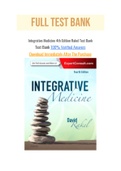Exam (elaborations)
Integrative Medicine 4th Edition Rakel Test Bank
Course
Integrative Medicine 4th Edition Rakel
Institution
Integrative Medicine 4th Edition Rakel
Integrative Medicine 4th Edition Rakel Test Bank. You have immediate access to download your test bank. No delays, loading is fast and instant immediately after ordering! You will receive a full bank of tests; in other words, all chapters will be there. Test banks are presented in PDF format; there...
[Show more]
Preview 4 out of 213 pages
Uploaded on
September 26, 2022
Number of pages
213
Written in
2022/2023
Type
Exam (elaborations)
Contains
Questions & answers
Institution
Integrative Medicine 4th Edition Rakel
Course
Integrative Medicine 4th Edition Rakel
By: karenwright • 4 months ago
$17.03
100% satisfaction guarantee
Immediately available after payment
Both online and in PDF
No strings attached
Full Test Bank




